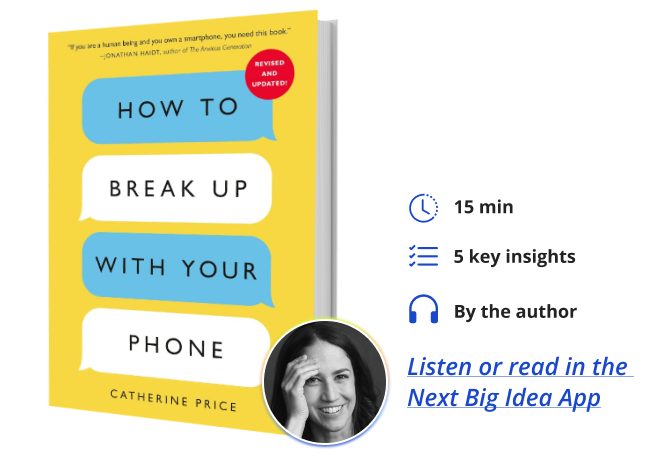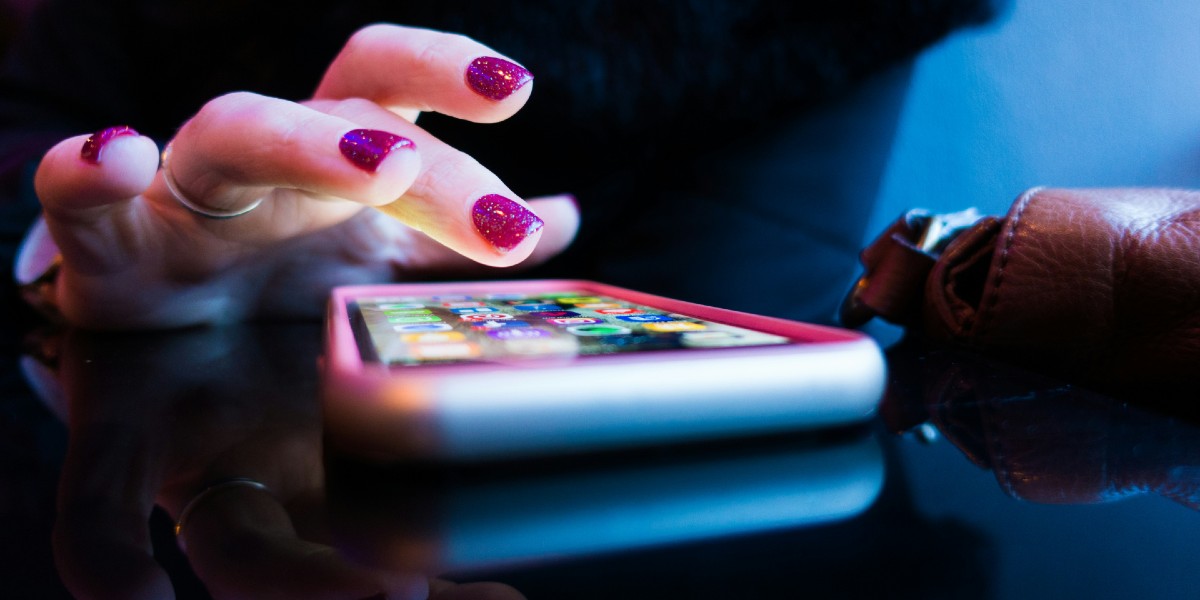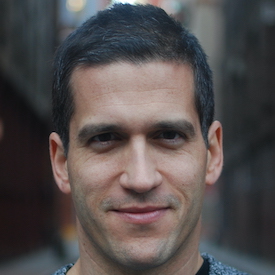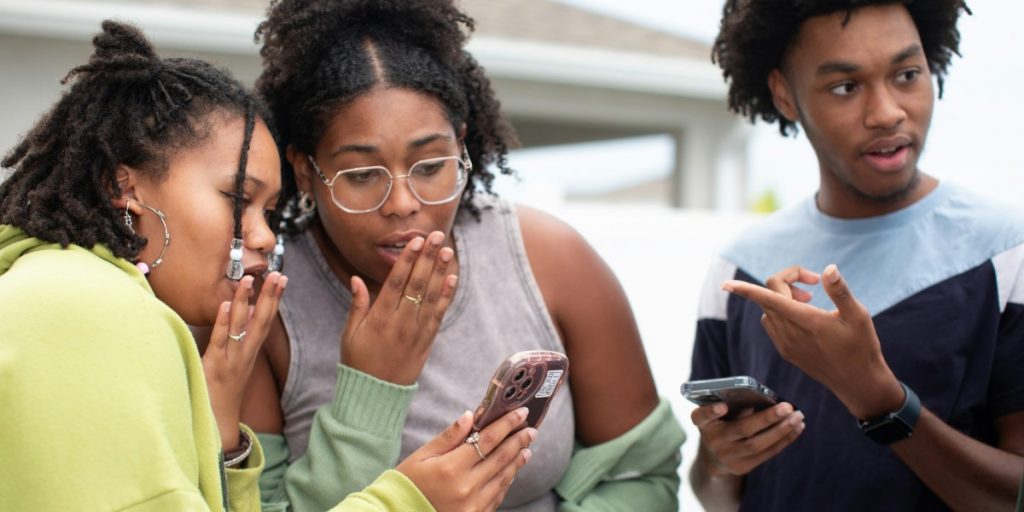Catherine Price is a health and science journalist, speaker, and consultant. Her work has appeared in many publications, including the New York Times, The Washington Post, and Popular Science. She writes the Substack newsletter How to Feel Alive.
What’s the big idea?
Smartphones have stolen an alarming amount of our attention—and therefore our lives. Apps are designed to feel irresistible, but when we finally peel our eyes off the screen, oftentimes only feelings of loneliness and boredom remain. To nurture habits that fill our precious time with fun, excitement, and connection, start by breaking up with your phone.
Below, Catherine shares five key insights from the revised edition of her book, How to Break Up with Your Phone. Listen to the audio version—read by Catherine herself—in the Next Big Idea App.

1. Define what you want.
One night about ten years ago, when my daughter was just a baby, I had a moment when I noticed that she was gazing up at me while I was gazing down at my phone—and it broke my heart. That was not the impression I wanted her to have of a human relationship, let alone with her own mother, and that was not how I wanted to live my own life.
The top reason that most people’s attempts to cut back on screen time fail is that they jump straight to “hacks” and “tricks” without first identifying why they’re trying to change their phone habits or what they want to be doing with their time. They set an arbitrary goal (my daily screen time must be one hour or less!) and attempt to achieve it by relying on willpower.
Relying on your willpower is a reliably bad way to change a habit. Eventually, it will run out, and you will end up back where you started, with the bonus of feeling like you failed. The point is not to restrict screen time arbitrarily; it’s to reconnect with your life.
Keep in mind that the people who design our most time-sucking apps make money from stealing our attention. That’s a big deal because our lives are what we pay attention to. We only experience what we pay attention to. We only remember what we pay attention to. When we allow app-makers to steal our attention, we’re allowing them to rob us of our lives.
“Relying on your willpower is a reliably bad way to change a habit.”
That’s why it’s essential to identify your motivation and goals. Why do you want to change your screen habits? What do you want to spend your time and attention on? What would a healthy relationship with your smartphone (and other devices) look like?
I encourage people to answer these questions by writing a “breakup letter” to their phone. It sounds silly at first, but it can be a surprisingly powerful way to clarify your motivations and goals. Here’s a sample breakup letter:
“Dear Phone: You fill my head with so much stuff I can’t hear my own thoughts. That’s the thing I resent the most. Why should you get to dictate what I think about, and when? I want to go back to a time when I had to entertain myself, to experience the way boredom breeds creativity, to learn the contours of my own mind and allow it to work at its own pace…I want the ability to stand still in a silent room…as silent as I can get with a three-year-old, anyway. As for my boy, I want him to see me, and know he is seen. What’s best for me is what’s best for him, too.” —C
It also can be useful to calculate how much time you currently spend on your phone and consider both how this compares to the amount of time you spend on the things you want to pay attention to and what the consequences will be if you continue with your current habits. Here’s a calculator that can help:
1 hour per day ≈ 15 full 24-hour days per year
2 hours per day ≈ 1 month per year
3 hours per day ≈ 1.5 months per year
4 hours per day ≈ 2 months per year
5 hours per day ≈ 2.5 months per year
6 hours per day ≈ 3 months per year
If those calculations aren’t sobering enough, consider how much of your conscious life is being consumed by your smartphone. If you’re awake for 16 hours a day and spend four hours a day on your phone (which is pretty typical), that means you’re spending 25 percent of your waking life on your phone. This also means that if you were to compress a year of screen time into one chunk, starting on January 1st (in other words, if you were to do nothing but sleep and stare at your phone), the rest of your “life” wouldn’t start until just after April 1st.
2. Reconnect with real life.
One of the main reasons we spend so much time on our phones is that we are not experiencing enough fun or connection in our actual lives. We’re bored (even if we’re overwhelmingly busy) and lonely. We turn to our phones to fill the emptiness we feel inside. Unfortunately, instead of nourishing us, the dopamine drip of our screens leaves us feeling emptier and more alone as soon as we look away from the phone. The more fun you create in real life, the less time you will want to spend on your smartphone.
What does nourish you? What do you find fun? What (and who) makes you feel lighthearted? What are you curious about? What makes you feel alive? What nourishing things can you do in quiet moments alone?
Either on your own or with your breakup partners, set a timer for 10 minutes and make a list of:
- Things you love doing (include a few that you can do on your own in quiet moments).
- Things you’re curious about trying. Like a recipe, a class, or a restaurant. Or maybe you’ve been curious about a habit, like meditating or going for an after-dinner walk.
- People you’d like to spend more time with.
This list will be an extremely useful tool for weekend planning, as well as for when you find yourself in a moment of downtime. If you are brainstorming with someone else, see if there are any things you could plan to do together—and then put those things into your calendars right then and there.
Notice how coming up with the list made you feel. Many people report that it can be hard, at first, to come up with non-screen-based ideas, but that once they get started, the flood gates open. They report feeling relieved and excited.
3. Make your phone boring.
Part of the reason it is so hard to look away from your smartphone is that its apps have deliberately been designed to feel exciting by manipulating our brains’ dopamine systems. Some tech insiders refer to these dopamine-triggering tactics as brain hacking. To fight back, make your phone as boring as possible.
Start by asking yourself what you like about your phone and want to keep using. Focus on apps that serve a tool-like purpose. Keep these and use them as much as you want. Next, delete or hide any app that is problematic for you—the ones that make you feel gross or guilty after you use them but which you find irresistible. They are probably some combination of social media, news, shopping, email, and gaming. Not coincidentally, categories of apps have the most similarities to slot machines.
If you’re hesitating about deleting anything, remember that you can always check these things from a computer or browser. It is the apps that are usually most problematic because they have so many features designed to hook you.
“Focus on apps that serve a tool-like purpose.”
Also, if you are the parent of teenagers, this is a great opportunity to role model behaviors. For added oomph, tell them what you’ve deleted—and ask them to hold you accountable. You could even have a family challenge to see who can keep their problem apps off their phone the longest.
I highly recommend using app blockers, which help you enforce your boundaries by setting access schedules. They are much more effective than the “screen time” features built into most smartphones. Popular options include apps such as Freedom, ScreenZen, and Opal, as well as physical devices such as the Brick and Unpluq tags.
To make your phone boring, you’ll also want to reduce your notifications—or as I call them, interruptions. What is worth being interrupted for when you are in the middle of a project? When you are putting your kids to bed? When watching a movie with your partner? Or laughing with friends? Start with an absolute minimum; you can always readjust your settings. Don’t forget to turn off those red badges that tell you how many things are waiting for you in an app. Those are notifications, too, and they’re there to get you to go into the app.
Once you’ve deleted (or hidden) problematic apps and reduced your notifications interruptions, redesign your home screen so that it only contains apps that either serve a practical purpose, or support a habit you want to engage in, such as meditation or learning a new language. Your home screen should contain only tools, not temptations. Your phone will be less like a slot machine and more like a Swiss army knife.
Here is an image of my own phone screen:

My home screen is totally empty, and I launch apps by pulling down the search bar and manually typing in their names. This helps me avoid opening apps on autopilot. I also have made it easy to toggle between color and black and white.
4. Create phone-free spaces.
Smartphones and apps infiltrated our lives so quickly and thoroughly that we never considered what we wanted our boundaries to be. As a result, it is nearly impossible to find any space—or gathering—that does not include smartphones. This is destroying our ability to be present and fully connected with each other, and it is also affecting our productivity, memories, creativity, and who we are as people!
Thankfully, an increasing number of schools are creating phone-free spaces for their students, but what about at home? One suggestion is to establish dinnertime as a “no phone zone.” To make device-free dinners feel less punitive and more fun, provide alternative activities. For example, you could create a system where every person takes turns coming up with a question of the day.
In addition to a bowl of conversation prompts, my husband and I also keep a “Jar of Delights” on our table with blank slips of paper. One of our favorite family rituals with our daughter (and with adult dinner guests) is to start dinner by writing down our daily delights and sharing them with each other as we add them to the jar.

If you enjoy device-free dinners, I suggest taking the concept further and experimenting with device-free family nights (have a movie or game night instead)—or even an entire device-free day. I encourage people to try taking a full 24-hour break from screens—a practice sometimes known as a Digital Sabbath. While most people are terrified at first, many report that it was the most enjoyable and valuable part of the entire 30-day breakup plan offered in the book.
5. Start and end the day on your own terms.
Your smartphone is probably the first thing you look at in the morning and the last thing you interact with before bed. If you can get your phone out of the bedroom, you will reclaim both of those times—and probably sleep better, too. If you are like most people, part of the reason your phone sleeps in your bedroom with you is because you use your phone as an alarm clock. To silence an alarm, you need to touch the alarm. If your smartphone is your alarm clock, you are guaranteeing that your smartphone will be the very first thing you interact with each day.
Get or find standalone alarm clocks for everyone in your family. Also, create a central family charging station for everyone’s phones that is not in a bedroom. For example, my husband and I charge our phones in a closet.
“Your smartphone is probably the first thing you look at in the morning and the last thing you interact with before bed.”
Next, place something you want to engage with or do before bed where your phone used to be. If you want to read more, set a book on your bedside table. This way, when you reach for your phone on autopilot, you’ll encounter a trigger for the habit you’re trying to establish. This is part of our overall strategy to make it harder to indulge in the habits you want to cut back on, while making it easier to develop the habits you want to nurture. Additionally, reading a book for ten minutes a day will help you rebuild your (likely atrophied) attention span!
Changing habits is hard, especially when they involve apps that are deliberately designed to make boundary-setting difficult. Our relationships with our phones will likely remain works-in-progress, and that’s okay. Eventually, you’ll find yourself with a new relationship with your devices that reflects what you already know in your heart: the best parts of life don’t happen on a screen.
To listen to the audio version read by author Catherine Price, download the Next Big Idea App today:
































